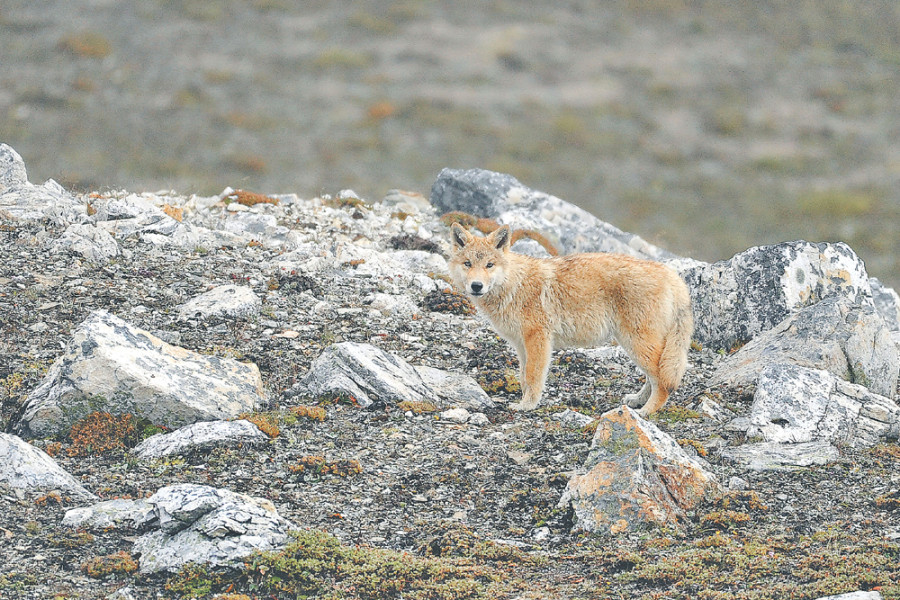Miscellaneous
The wolves of Manang
The successful tracking of wolves in Upper Manang has researchers jubilant and local herders concerned
Sanjit Bhakta Pradhananga
On September 2, a team of researchers surveying snow leopard signs and conducting a prey count in the upper valley of Khangsar, Manang were not expecting anything out of the ordinary. But at 4:40 pm, on their way back to camp, the team would stumble upon a chance discovery that would reverberate in the valleys below and the world beyond.
For the first time in more than four decades, a pack of Himalayan wolves were roaming the remote pastures of Manang.
“It happened so quickly,” says biologist Tashi Ghale, a member of the team, “We were able to snap a few quick pictures before they disappeared behind the cover of rocks.”
The team, from Global Primate Network-Nepal (GPN), have been conducting camera trapping surveys of snow leopards and Pallas’s cats in the region in collaboration with National Trust for Nature Conservation. “We had first captured images of a wolf pair in one of our camera traps at an elevation of 4590m on March 31, 2015. But we thought the wolves might just be roaming and speculated that they would go back where they came from,” Ghale says.
“But now the wolf pair seems to have successfully reproduced and colonised the upper pasture of Khangsar, which has a wide valley and a good prey base. We sighted a pack of five wolves altogether,” says Rinzin Phunjok Lama, principal investigator of the team, “The successful colonisation of the wolves might compete with the valley’s apex predator, the snow leopard”
The Himalayan wolf is still classified as an off-shoot of the Tibetan wolf (Canis lupus chanco), sub-species of the gray wolf (Canis lupis). The wolves, however, are distinct from their European and North American cousins because of the white colouration around the throat, chest, belly and inner part of the legs; woolliness of body fur; stumpy legs and unusual elongation of the muzzle. Some researchers have suggested that because the wolf split off from the canine lineage 630,000 to 800,000 years ago, evolving in isolation, the species deserves further study and concerted conservation efforts.
In April this year, a report, published by a team headed by researcher Madhu Chettri, grabbed headlines around the world. The team that had been studying stool samples in Upper Mustang since 2001 confirmed the presence of the Himalayan wolf in the Mustang region. The paper, Ancient Himalayan wolf lineage in Upper Mustang of the Annapurna Conservation Area, published in the journal ZooKeys, also speculated that Himalayan wolves, which are genetically distinct from European grey wolves, merit to be classified as a species of their own—Canis himalayensis.
As part of the research, the team interviewed hundreds of local herders, livestock owners and nomads, who admitted that wolves will be seen as a threat to local livelihoods. “These genetically distinct Himalayan wolves deserve special conservation attention, at the same time that the conservation of this species in a context of human-wildlife conflict is challenging,” the paper concluded. “A species action plan needs be formulated that develops mechanisms to minimise conflict, and strategies for motivating local communities towards wolf conservation.”
Inevitable conflict
Locally known as ‘chengu’, GPN-N researchers confirm that the locals are concerned by the return of the species to the Manang valley. Buchung Gurung, a herder from Tenki, Manang, remembers sighting a wolf chasing goat in the Karche pasture as a child. According to him, wolves have not again been sighted in the region for four decades. “Now that the wolf has again returned to the valley, it will be dangerous for the livestock. A pack can bring down big animals,” Gurung said.
Ganga R Regmi, the executive director of GPN Nepal, says that while wolves can play a big role in balancing out the food chain and easing pressure on grazing pastures, eventual conflict is all but inevitable. “Because wolves are robust pack hunters they will inevitably come into conflict with not just other predators like the snow leopard, but also humans,” he says, “A yak will cost a herder roughly Rs 100,000, there are bound to be retribution killings in the future, if long-term conservation policies are not formulated. Poisoning of the wolves by herders has played a significant role in the dwindling of their numbers in the past.”
According to Regmi, the lack of comprehensive study has made it impossible to ascertain the population of the wolves that roam Dolpa, Humla, Kanchenjunga, Mustang and now Manang. Wolves are listed critically endangered in IUCN National Red List and are legally protected by the National Park and Wildlife Conservation Act 1973 of the Government of Nepal. “Tigers, rhinos and red pandas have received plenty of worldwide attention in the past decade and giant strides have been made in their conservation. The endangered Himalayan wolf deserves concerted conservation efforts as well.” Given the abundance of prey in the valley, Regmi estimates that the wolves that have already colonised Khangsar are bound to flourish—making the need for further study and proactive action all the more urgent.
For now though, he and his team are overjoyed that the howl of wolves will ring the valleys of Manang once more.




 14.12°C Kathmandu
14.12°C Kathmandu








%20(1).jpg&w=300&height=200)

